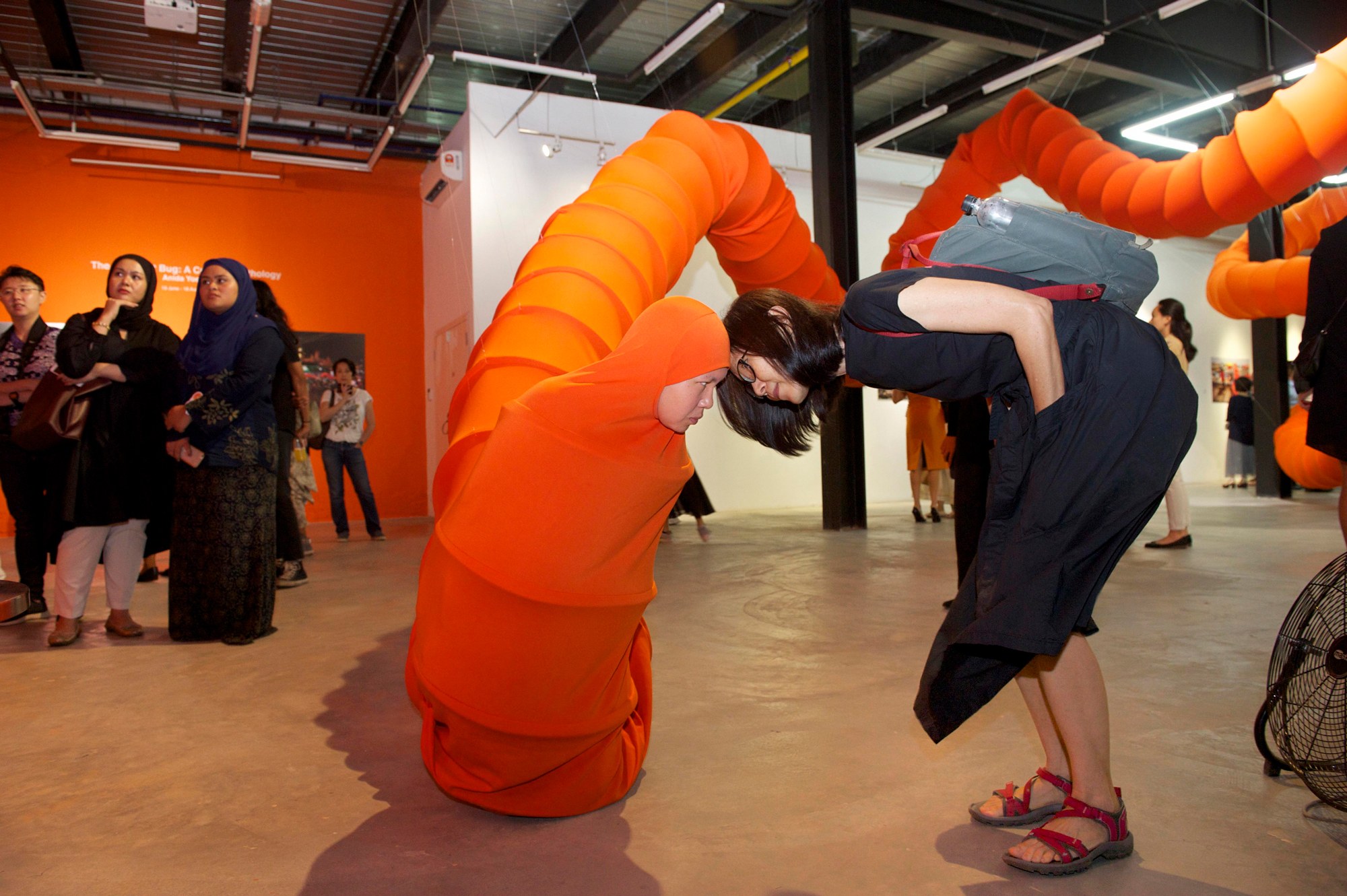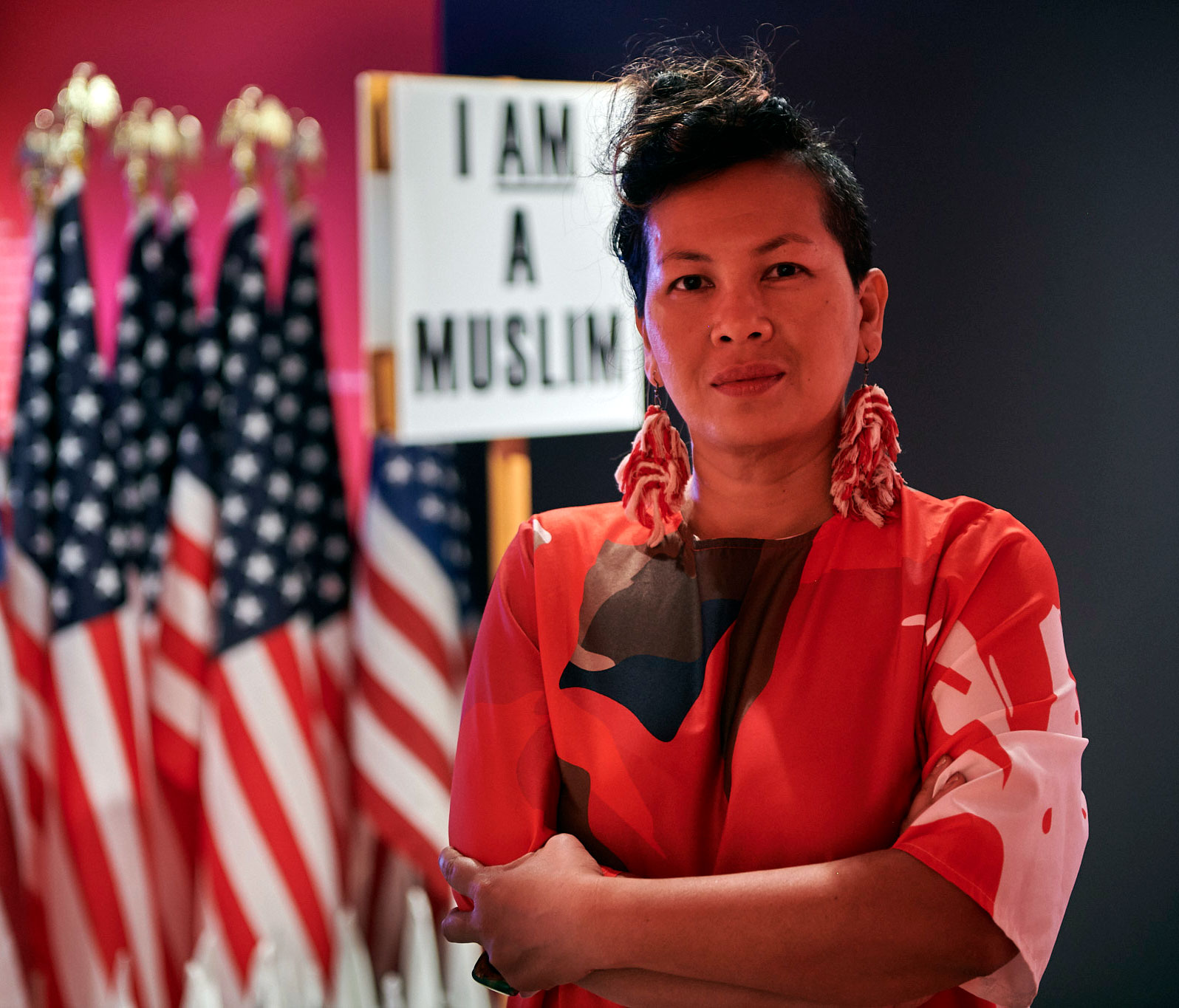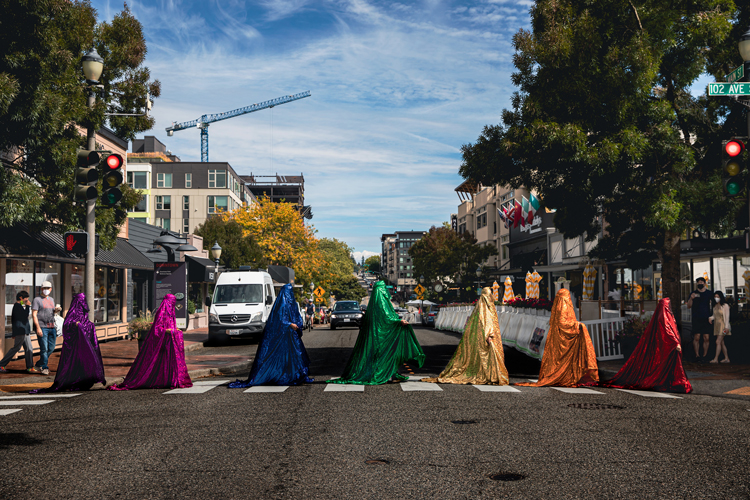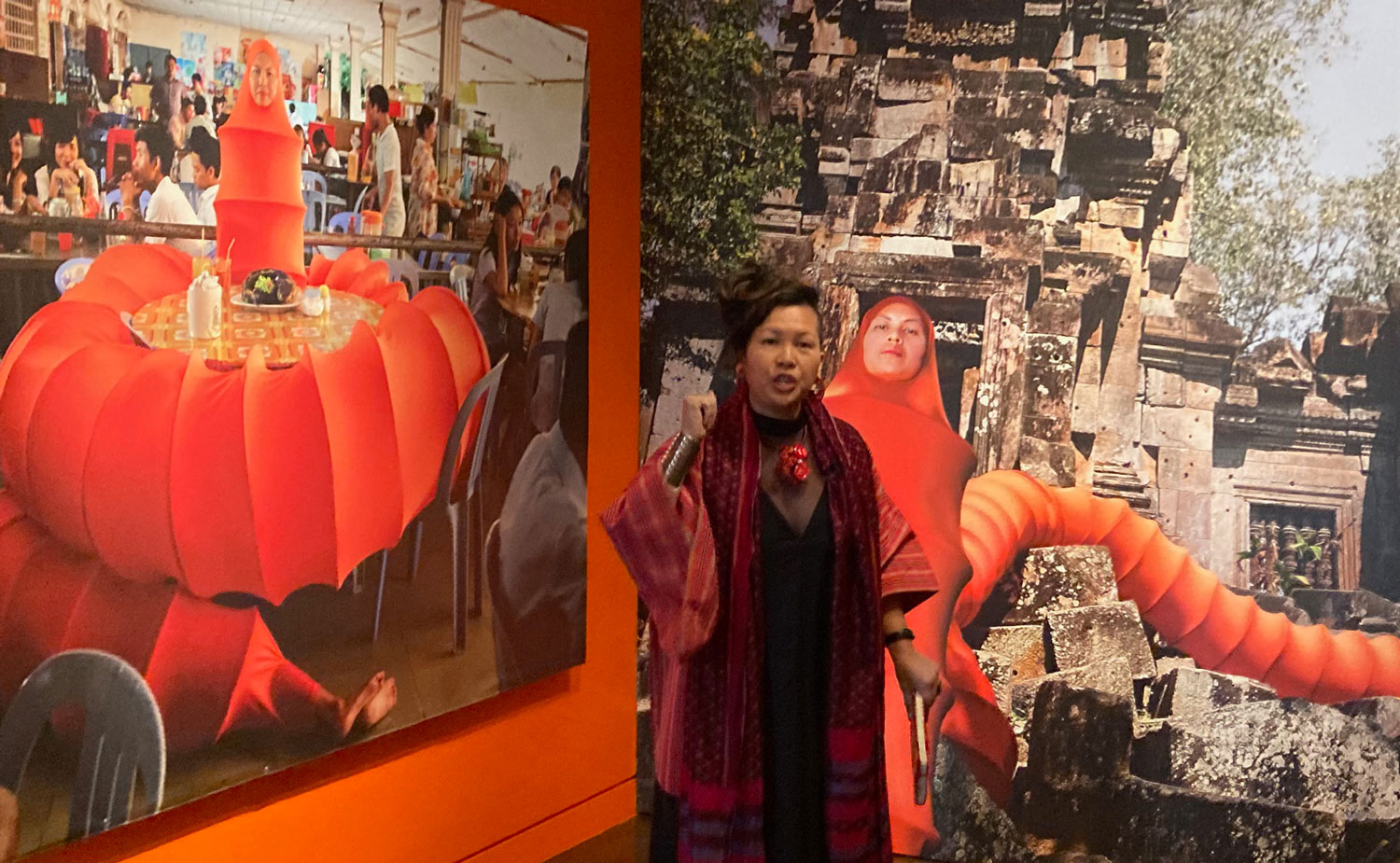Artist, agitator, bug Artist, agitator, bug Artist, agitator, bug
UW Bothell Senior Artist-in-Residence Anida Yoeu Ali opens a solo show that fills the Seattle Asian Art Museum with living color.

UW Bothell Senior Artist-in-Residence Anida Yoeu Ali opens a solo show that fills the Seattle Asian Art Museum with living color.
Last November, Anida Yoeu Ali worked feverishly with a team of volunteers to stretch giant vinyl photos of her performances onto wood and aluminum frames. Assembling the lively, large-scale project for her upcoming solo show at Seattle Asian Art Museum, she had no time to waste. She had just a few days to do it all before leaving for Cambodia for a month, where she worked on finalizing a sculptural piece for her SAAM show.
Ali, a senior artist-in-residence at UW Bothell, has exhibited and performed around the world, from Phnom Penh to Paris. Her “Red Chador” performance—where she dons a sequined full-body cloak and even covers her face—debuted in 2015 in France, where it is illegal to wear face coverings. The costume commentary on what it is to be Muslim and about prejudice and hate crimes has appeared in cities including Seattle, Hong Kong, Washington, D.C., and Tel Aviv.
Born in Battambang, Cambodia and raised in Chicago after her family fled their homeland to escape the Khmer Rouge, Ali takes on serious subjects like her Cambodian American experience, being Muslim in a Buddhist space, and gender and identity, and explores them in colors and costumes that are both unsettling and endearing, even charming. Her vibrant “Buddhist Bug” costume is 100 meters long. Her face peeks from one orange end. Seeing her embody the bug and seeing people around her respond can spark curiosity, even delight.

Anida Yoeu Ali photographed by Scott Leen, courtesy of Seattle Art Museum.
Though she’s primarily a performance artist, Ali’s museum exhibition focuses on performance installation: photos and videos that document her time-based, site-specific work. At the Volunteer Park museum show, “Hybrid Skin, Mythical Presence,” visitors can interact with a variety of Ali’s art. The large-scale photographic murals of Ali and others in costume and out in streetscapes often capture public encounters. Videos show her art in action—as she stands in a public space and the people nearby either respond or ignore her. Various performance-related artifacts, including the textiles she and others wear in her performances, fill the quiet, 90-year-old Seattle museum with color. As if that’s not engaging enough, Ali will activate the exhibition with two performances this spring.
The SAAM show is an important moment for her and her community, Ali says. It marks her solo debut at a museum and the first time that SAAM has ever presented a Cambodian American artist. Ali notes that the themes in her work, like the history of war, trauma and genocide, are not frequently presented in mainstream cultural institutions. She seeks to be politically provocative and aesthetically remarkable while also conveying playfulness and joy. With this show, the artist hopes to invite new visitors from historically underrepresented communities into the space of the museum.
The SAAM show includes video documentation of Ali’s work since 2009, paired with the extraordinary costumes from her iconic projects “The Red Chador” and “The Buddhist Bug.” The Buddhist Bug suit winds around and across the rooms. The wearable, tubular garment is a bright orange soft sculpture that occupies both volume and space. Ali says the project speaks to themes of displacement and belonging, and “figuring out who you are and how you present yourself to the outside world.”
“The bug is not a very fast creature and doesn’t do much except for really being present and aware,” says Ali. “She agitates as much as she can with her eyes and her face. And how she sways and wiggles and lures people forward.” The public is encouraged to get as close to Ali as possible and to be daring. Ali finds that children are the most courageous and curious in engaging with her as “The Buddhist Bug.” Ali knows her work won’t reach or connect to everyone, so she focuses on speaking to the audiences who don’t see enough of themselves or their stories reflected back to them.

Performance artist Anida Yoeu Ali and her fellow performers appear in Bellevue in 2021. The piece is titled ‘Abbey Road, the Red Chador: Genesis.’
“I want my students to be able to see parts of themselves in this work and know that they can dream to be an artist, too.”
Anida Yoeu Ali
Ali initially studied graphic design, choosing a field that she thought would please her parents enough while still allowing her to take art classes. She minored in art education as a practical backup. During college, she threw her energies into activism. She organized with other students at the University of Illinois Urbana-Champaign to advocate for an Asian American studies program and cultural center. Her activities brought her into the world of creative writing, poetry and literary magazines through which she discovered artists who weren’t mentioned in her art survey classes.
After college, Ali realized how expensive an art-making practice can be. So she started composing spoken-word poetry and formed the legendary performance poetry group I Was Born With Two Tongues (1998-2003). Later, she organized a multi-media theater group across several cities called Mango Tribe. “We made experimental work engaging with themes of domestic violence, queer bodies and sexual assault,” she says. As Ali toured the world as a spoken-word artist, she realized that she couldn’t fully broach the language divide between herself and her audiences. So she began to shift from poetry to non-verbal and visual performance art. Ali enrolled at The School of the Art Institute of Chicago for a performance degree and found her medium. “That was when I started experimenting with a form called performance installation, which is what the SAAM exhibition will showcase,” says Ali.
In 2016, she began her artist’s residency at UW Bothell. “We lived in Cambodia from 2011 to 2015 and made the decision as a family to come back to the U.S.—mainly for the children’s education,” Ali says. She had been a visiting assistant professor at Trinity College in Connecticut for a year before being drawn to the UW Bothell position. She was “excited about UWB’s interdisciplinarity and their social-justice angle,” adding it was also easier to travel to the Asia Pacific region from the West Coast.
As an artist, Ali has been grateful how UW Bothell supported her teaching a range of innovative and imaginative classes. In addition to her “global agitation” class on art and activism and a course on contemporary ‘Muslim’ artists, Ali also teaches performance for non-dancers, Southeast Asian hip-hop and urban art, and an introduction to spoken word. Finally, she teaches a global media filmmaking intensive with her life partner and artistic collaborator, filmmaker Masahiro Sugano. He also a senior artist-in-residence on the Bothell campus.

Anida Yoeu Ali speaks about her Seattle Asian Art Museum exhibit. Photo by Shin Yu Pai.
Ali acknowledges the significant creative role Sugano has played in her work. The SAAM show includes print and video collaborations between the couple. “He’s been my biggest champion,” Ali says. “I collaborate with a lot of other photographers, but Masa gets it so instantly. When he’s involved, I don’t have to worry.”
Ultimately, Ali wants her students to know that being an artist is within anyone’s reach. She encourages them to think creatively, take risks and have the courage to make something and finish it. Ali’s own practice brings her many complex identities into her work. “Someone like me—I’m a mother, a Muslim feminist and an ethnically mixed Asian American. I hold these different identities as a genocide survivor and as a diasporic artist,” she says. “I want my students to be able to see parts of themselves in this work and know that they can dream to be an artist, too.”
On sabbatical this year, Ali is making art full-time. Beyond preparing her solo show at SAAM, she has participated in festivals in Copenhagen and Paris and is spending time at her studio in Cambodia.
Ali’s solo show at SAAM runs from Jan. 18 through July 7. Audiences of all ages will have the opportunity to see the garment come to life and the fantasy element of “The Buddhist Bug” on March 23, during a full day of family programming hosted by SAAM. On June 1, Ali is planning a longer performance with “The Red Chador.” She will pair “The Red Chador” with a vibrant rainbow of other sequined chadors that will activate all three of Seattle Art Museum’s locations at the Olympic Sculpture Park, SAAM and downtown. “I’m working with SAAM to figure out the map of how we’re going to spend all those hours traversing Seattle downtown and other corners,” says Ali.